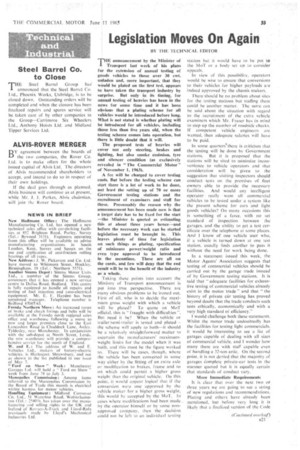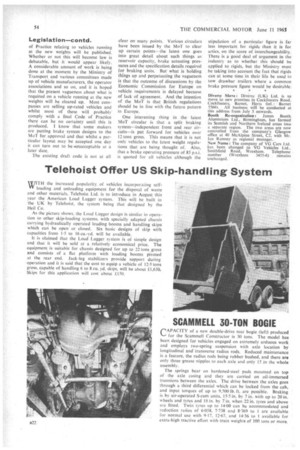Legislation Moves On Again
Page 55

Page 56

If you've noticed an error in this article please click here to report it so we can fix it.
BY THE TECHNICAL EDITOR 7"1.1E announcement by the Minister of
Transport last week of his plans for the extension of annual testing of goods vehicles to .those over 30 cwt. Unladen and, more important, that they would he plated on the first test, appears to have taken the transport industry by surprise. But only in its timing, for annual testing_ of heavies has been in the news for some time and it has been obvious that a plating scheme for all vehicles would be introduced before long. What is not stated is whether plating will he introduced for all vehicles, including those less than -five years old, when the testing scheme comes into operation, but there is little doubt that it will.
The proposed tests of heavies will cover not only steering, brakes and lighting, but also smoke emission, tyre and 'silencer condition (as exclusively revealed in "The Commercial Motor" or November 1, 1963).
A. fee will he charged to cover testing costs. But before the testing scheme Can start .there is a hit of work to be done, not least the setting up of 70 or more Government testing stations and the recruitment of examiners and staff for these, rresumahly the reason why the announcement has been made now is that a target date has to be fixed for the start —tile Minister is quoted as estimating this at about three years bence--and before the .necessary work can be started legislation must be brought in. This leaves plenty of time for legislation on such things as plating, specification of minimum power/weight ratio and even type approval to be introduced in the meantime. These are all on the cards, and few will deny that the end result will be to the benefit of the industry as' a whole.
Taking these points into account the Ministry of Transport Announce men t is put into true perspective. There are many obvious problems 10 be ironed out. First of all, who is to decide the maximum gross weight with which a vehicle will be plated? To quote an MoT official, this is " fraught with difficulties ". But need it be? When the vehicle or traileriserni-irailer is tested and plated-the scheme will apply to both—it should be a relatively straightforward matter to ascertain the manufacturers' maximumweight limits for the model when it was built., and this must he the figure worked to. There will be cases, though. where the vehicle has been converted in sonic way either by the fitting of an extra axle or modification to brakes, frame and so on which could permit a higher gross weight than the original vehicle. On this point, it would appear logical that if the conversion were one approved by the vehicle maker for a highergross weight. this would he accepted by the MoT, lii cases where modifications had been made by the operator himself or by some nonapproved :company, then the decision could 1101 he Tell to an individual resting station but it would have to be put to the MoT or a body set up to consider appeals.
In view of this possibility, operators would be wise to ensure that conversions to their vehicles for higher payloads are indeed approved by the chassis makers.
There should be no problem about sites for the testing stations but staffing them could be another matter. The same cart he said about the situation with regard to the recruitment of the extra vehicle examiners which Mr. Fraser has in mind to step up the number of roadside cheeks. If competent vehicle engineers are wanted, then adequate salaries will have to be paid.
In some quarterssthcre is criticism that the testing will be done by GoVernment stations. But it is proposed that the stations will he sited to minimize inconvenience to vehicle operators and that consideration will be given to the suggestion that visiting inspectors should conduct tests on the premises of fleet owners able to provide the necessary facilities. Add would any intelligent operator really want all commercial vehicles to be tested under a system, like the present scheme for cars and light goods vehicles? On many occasions this is something of a farce, with no set standard of inspection between the garages, and the ability to get a test certificate over the telephone at some places. And I know of one vehicle user who, if a vehicle is turned down at one test station, usually finds another to pass it without the need for work being done.
In a statement issued this week, the Motor Agents' Association suggests that testing of commercial vehicles should he carried out by the garage trade instead of by Government testing stations. It is said that adequate facilities for exhaustive testing of commercial vehicles already exist in the motor trade" and that "the history Of private cif testing has proved beyond doubt that the trade conducts such tests ethically, economically and with a very high standard of efficiency."
I would challenge both these statements. Whilst the motor trade undoubtedly has the facilities for testing light commercials. it would he interesting to see a list of garages capable of dealing with all sizes of commercial vehicle, and I wonder how many there are with staff capable even of handling a 32-ton artic. On the second point, it is not denied that the majority of garages complete private-ear tests in the manner quoted but it is equally certain that standards of conduct vary.
More Immediate Requirements
It is clear that over the next two or three years we are going to see a string of new regulations and recommendations. Plating and others have already been mentioned, but before vers long it is likely that a finalized version of the Code of Practice relating to vehicles running at the new weights will be published. Whether or not this will become law is debatable, but it would appear likely. A considerable amount of work is being done at the moment by the Ministry of Transport and various committees made up of vehicle manufacturers, the operator associations and so on, and it is hoped that the present vagueness about what is required on a vehicle running at the new weights will be cleared up. Most companies are selling up-rated vehicles and whilst most of these will probably comply with a final Code of Practice there can be no certainty until this is produced. I know that some makers are putting brake system designs to the MoT for approval and that whilst a particular layout may be accepted one day it can turn out to be .unacceptable at a later date.
The existing draft code is not at all clear on many points. Various circulars have been issued by the MoT to clear up certain points—the latest one goes into great detail about such things as reservoir capacity, brake actuating pressures and the specification details required for braking units. But what is holding things up and perpetuating the vagueness is that the outcome of discussions by the Economic Commission for Europe on vehicle requirements is delayed because of lack of agreement. And the intention of the MoT is that British regulations should be in line with the future pattern in Europe.
One interesting thing in the latest MoT circular is that a split braking system—independent front and rear circuits—is put forward for vehicles over 12 tons gross. This means that it is not only vehicles to the latest weight regulations that are being thought of. Also, that a brake operating pressure of 85 p.s.i. is quoted for all vehicles although the stipulation of a particular figure is far less important for rigids than it is for
artics, on the score of interchangeability. There is a good deal of argument in the industry as to whether this should be applied to rigids, but the Ministry must be taking into account the fact that rigids can at some time in their life be used to
tow drawbar trailers where a common brake pressure figure would be desirable.
Diversy Move: Diversy (UK) Ltd. is to move to new premises in Cockfosters Road, Cockfosters, Barnet, Herts (tel.: Barnet 5566). All business will be conducted at this address from July 5 onwards.
Booth Re-organintion : James Booth Aluminium Ltd.. Birmingham, has formed its Scottish and Northern Ireland areas into a separate region. The two areas are now controlled from the company's Glasgow office at 40 McAlpine Street, C2, with Mr. Ian Ramsey as regional manager.
NeW Name: The company of VG Cars Ltd. has been changed to VG Vehicles Ltd., Smithfield Road, Wrexham. Telephone number (Wrexham 3455-6) remains unchanged.




























































































































